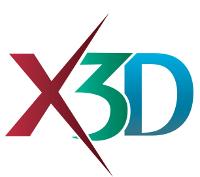X3D Standards
The X3D Standards Working Group addresses all X3D specification issues and coordinates the technical development of future improvements.
 X3D Standards Working Group
X3D Standards Working Group
This group meets every Friday from 09-10:00 AM pacific and discussions occur on the x3d-public and X3D (member-only) mailing lists. Web3D Calendar
Member-only resources: Meeting Link, Agenda, Minutes and Documents The Extensible 3D (X3D) Standards Working Group forms the core of the working groups within the Web3D Consortium. It is responsible for the development of specification of core technologies for the X3D suite of Specifications, and the integration of the specifications for non-core technologies and coordinating the technical aspects of all Web3D working group efforts. The X3D Graphics Standards: Specification Relationships graphic nicely illustrates the interaction and relationships between the various X3D specifications.
Interest in augmented reality, improvements in audio and visual fidelity, and new encodings including JSON and streaming binary are driving the development of the next revision of the standard. The Working Group is looking for people to help with these and other technical fields in creating the X3D V4.0 standard.
The wide-spread adoption of WebGL in all browsers is driving X3D into the future. The next generation of X3D (V4.0) will be embedded in the browser and support full interaction with the web page. It will include all of the features of X3D that are currently available plus new rendering, interaction, and device support all running in your browser, whether it is on your desktop or your phone. In addition to X3D continuing to work in non-browser environments.
Activities
- Integrating X3D into HTML/DOM web pages for X3D version 4 and achieving other improvements such as advanced glTF rendering and spatial audio.
- Develop the specifications and manage the Web3D/ISO processes for the X3D International Standards.
- The Working Group meets every week to discuss, develop, and approve the current topics. These include reviewing new technologies, integration of submitted technologies, and interfacing with external organizations for X3D.
- Encourage tool updates and content validation for all forms of X3D4.
- Apply various techniques to achieve goals listed in Call for Contributions for Compressed Binary Encoding for X3D.
History
The X3D Working Group was formed in 1999 to handle new technology updates and shortcomings in VRML. It produced X3D V3.0, an evolutionary progression from VRML 97, in 2003 as an ISO Specification (ISO/IEC 19775-1). The intiial document is the abstract description of capabilities. It was followed by X3D's API - Scene Access Interface (SAI), three encodings (ClassicVRML, XML, and Compressed Binary), and two SAI language bindings (JavaScript and Java). In June 2024 the working group name was changed to X3D Standards.
X3D V3.3 is complete and formalized under ISO. It contained significant enhancements and capabilities from the original V3.0, including shaders, geo-spatial handling, 3D volume rendering, and 2D geometry.
The standards currently comprise the following documents:
| Type | Name | ISO/IEC Number |
|---|---|---|
| Abstract Definition | X3D | 19775-1 |
| Scene Access Interface | 19775-2 | |
| Encodings | XML | 19776-1 |
| ClassicVRML | 19776-2 | |
| Compressed Binary | 19776-3 | |
| Language Bindings | ECMAScript | 19777-1 |
| Java | 19777-2 |



